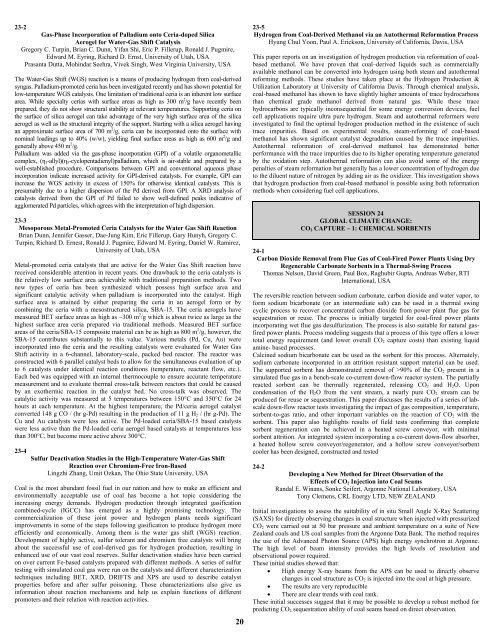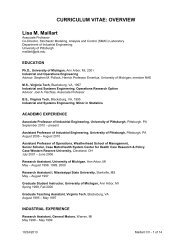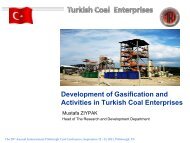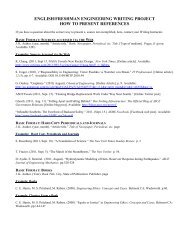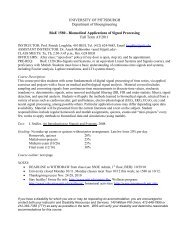Abstract Booklet 2006 - Swanson School of Engineering - University ...
Abstract Booklet 2006 - Swanson School of Engineering - University ...
Abstract Booklet 2006 - Swanson School of Engineering - University ...
You also want an ePaper? Increase the reach of your titles
YUMPU automatically turns print PDFs into web optimized ePapers that Google loves.
23-2<br />
Gas-Phase Incorporation <strong>of</strong> Palladium onto Ceria-doped Silica<br />
Aerogel for Water-Gas Shift Catalysis<br />
Gregory C. Turpin, Brian C. Dunn, Yifan Shi, Eric P. Fillerup, Ronald J. Pugmire,<br />
Edward M. Eyring, Richard D. Ernst, <strong>University</strong> <strong>of</strong> Utah, USA<br />
Prasanta Dutta, Mohindar Seehra, Vivek Singh, West Virginia <strong>University</strong>, USA<br />
The Water-Gas Shift (WGS) reaction is a means <strong>of</strong> producing hydrogen from coal-derived<br />
syngas. Palladium-promoted ceria has been investigated recently and has shown potential for<br />
low-temperature WGS catalysis. One limitation <strong>of</strong> traditional ceria is an inherent low surface<br />
area. While specialty cerias with surface areas as high as 300 m 2 /g have recently been<br />
prepared, they do not show structural stability at relevant temperatures. Supporting ceria on<br />
the surface <strong>of</strong> silica aerogel can take advantage <strong>of</strong> the very high surface area <strong>of</strong> the silica<br />
aerogel as well as the structural integrity <strong>of</strong> the support. Starting with a silica aerogel having<br />
an approximate surface area <strong>of</strong> 700 m 2 /g, ceria can be incorporated onto the surface with<br />
nominal loadings up to 40% (w/w), yielding final surface areas as high as 600 m 2 /g and<br />
generally above 450 m 2 /g.<br />
Palladium was added via the gas-phase incorporation (GPI) <strong>of</strong> a volatile organometallic<br />
complex, (η 3 -allyl)(η 5 -cyclopentadienyl)palladium, which is air-stable and prepared by a<br />
well-established procedure. Comparisons between GPI and conventional aqueous phase<br />
incorporation indicate increased activity for GPI-derived catalysts. For example, GPI can<br />
increase the WGS activity in excess <strong>of</strong> 150% for otherwise identical catalysts. This is<br />
presumably due to a higher dispersion <strong>of</strong> the Pd derived from GPI. A XRD analysis <strong>of</strong><br />
catalysts derived from the GPI <strong>of</strong> Pd failed to show well-defined peaks indicative <strong>of</strong><br />
agglomerated Pd particles, which agrees with the interpretation <strong>of</strong> high dispersion.<br />
23-3<br />
Mesoporous Metal-Promoted Ceria Catalysts for the Water Gas Shift Reaction<br />
Brian Dunn, Jennifer Gasser, Dae-Jung Kim, Eric Fillerup, Gary Hunyh, Gregory C.<br />
Turpin, Richard D. Ernest, Ronald J. Pugmire, Edward M. Eyring, Daniel W. Ramirez,<br />
<strong>University</strong> <strong>of</strong> Utah, USA<br />
Metal-promoted ceria catalysts that are active for the Water Gas Shift reaction have<br />
received considerable attention in recent years. One drawback to the ceria catalysts is<br />
the relatively low surface area achievable with traditional preparation methods. Two<br />
new types <strong>of</strong> ceria has been synthesized which possess high surface area and<br />
significant catalytic activity when palladium is incorporated into the catalyst. High<br />
surface area is attained by either preparing the ceria in an aerogel form or by<br />
combining the ceria with a mesostructured silica, SBA-15. The ceria aerogels have<br />
measured BET surface areas as high as ~300 m 2 /g which is about twice as large as the<br />
highest surface area ceria prepared via traditional methods. Measured BET surface<br />
areas <strong>of</strong> the ceria/SBA-15 composite material can be as high as 800 m 2 /g, however, the<br />
SBA-15 contributes substantially to this value. Various metals (Pd, Cu, Au) were<br />
incorporated into the ceria and the resulting catalysts were evaluated for Water Gas<br />
Shift activity in a 6-channel, laboratory-scale, packed bed reactor. The reactor was<br />
constructed with 6 parallel catalyst beds to allow for the simultaneous evaluation <strong>of</strong> up<br />
to 6 catalysts under identical reaction conditions (temperature, reactant flow, etc.).<br />
Each bed was equipped with an internal thermocouple to ensure accurate temperature<br />
measurement and to evaluate thermal cross-talk between reactors that could be caused<br />
by an exothermic reaction in the catalyst bed. No cross-talk was observed. The<br />
catalytic activity was measured at 5 temperatures between 150°C and 350°C for 24<br />
hours at each temperature. At the highest temperature, the Pd/ceria aerogel catalyst<br />
converted 148 g CO / (hr g-Pd) resulting in the production <strong>of</strong> 11 g H 2 / (hr g-Pd). The<br />
Cu and Au catalysts were less active. The Pd-loaded ceria/SBA-15 based catalysts<br />
were less active than the Pd-loaded ceria aerogel based catalysts at temperatures less<br />
than 300°C, but become more active above 300°C.<br />
23-4<br />
Sulfur Deactivation Studies in the High-Temperature Water-Gas Shift<br />
Reaction over Chromium-Free Iron-Based<br />
Lingzhi Zhang, Umit Ozkan, The Ohio State <strong>University</strong>, USA<br />
Coal is the most abundant fossil fuel in our nation and how to make an efficient and<br />
environmentally acceptable use <strong>of</strong> coal has become a hot topic considering the<br />
increasing energy demands. Hydrogen production through integrated gasification<br />
combined-cycle (IGCC) has emerged as a highly promising technology. The<br />
commercialization <strong>of</strong> these joint power and hydrogen plants needs significant<br />
improvements in some <strong>of</strong> the steps following gasification to produce hydrogen more<br />
efficiently and economically. Among them is the water gas shift (WGS) reaction.<br />
Development <strong>of</strong> highly active, sulfur tolerant and chromium free catalysts will bring<br />
about the successful use <strong>of</strong> coal-derived gas for hydrogen production, resulting in<br />
enhanced use <strong>of</strong> our vast coal reserves. Sulfur deactivation studies have been carried<br />
on over current Fe-based catalysts prepared with different methods. A series <strong>of</strong> sulfur<br />
testing with simulated coal gas were run on the catalysts and different characterization<br />
techniques including BET, XRD, DRIFTS and XPS are used to describe catalyst<br />
properties before and after sulfur poisoning. Those characterizations also give us<br />
information about reaction mechanisms and help us explain functions <strong>of</strong> different<br />
promoters and their relation with reaction activities.<br />
20<br />
23-5<br />
Hydrogen from Coal-Derived Methanol via an Autothermal Reformation Process<br />
Hyung Chul Yoon, Paul A. Erickson, <strong>University</strong> <strong>of</strong> California, Davis, USA<br />
This paper reports on an investigation <strong>of</strong> hydrogen production via reformation <strong>of</strong> coalbased<br />
methanol. We have proven that coal–derived liquids such as commercially<br />
available methanol can be converted into hydrogen using both steam and autothermal<br />
reforming methods. These studies have taken place at the Hydrogen Production &<br />
Utilization Laboratory at <strong>University</strong> <strong>of</strong> California Davis. Through chemical analysis,<br />
coal-based methanol has shown to have slightly higher amounts <strong>of</strong> trace hydrocarbons<br />
than chemical grade methanol derived from natural gas. While these trace<br />
hydrocarbons are typically inconsequential for some energy conversion devices, fuel<br />
cell applications require ultra pure hydrogen. Steam and autothermal reformers were<br />
investigated to find the optimal hydrogen production method in the existence <strong>of</strong> such<br />
trace impurities. Based on experimental results, steam-reforming <strong>of</strong> coal-based<br />
methanol has shown significant catalyst degradation caused by the trace impurities.<br />
Autothermal reformation <strong>of</strong> coal-derived methanol has demonstrated better<br />
performance with the trace impurities due to its higher operating temperature generated<br />
by the oxidation step. Autothermal reformation can also avoid some <strong>of</strong> the energy<br />
penalties <strong>of</strong> steam reformation but generally has a lower concentration <strong>of</strong> hydrogen due<br />
to the diluent nature <strong>of</strong> nitrogen by adding air as the oxidizer. This investigation shows<br />
that hydrogen production from coal-based methanol is possible using both reformation<br />
methods when considering fuel cell applications.<br />
SESSION 24<br />
GLOBAL CLIMATE CHANGE:<br />
CO 2 CAPTURE – 1: CHEMICAL SORBENTS<br />
24-1<br />
Carbon Dioxide Removal from Flue Gas <strong>of</strong> Coal-Fired Power Plants Using Dry<br />
Regenerable Carbonate Sorbents in a Thermal-Swing Process<br />
Thomas Nelson, David Green, Paul Box, Raghubir Gupta, Andreas Weber, RTI<br />
International, USA<br />
The reversible reaction between sodium carbonate, carbon dioxide and water vapor, to<br />
form sodium bicarbonate (or an intermediate salt) can be used in a thermal swing<br />
cyclic process to recover concentrated carbon dioxide from power plant flue gas for<br />
sequestration or reuse. The process is initially targeted for coal-fired power plants<br />
incorporating wet flue gas desulfurization. The process is also suitable for natural gasfired<br />
power plants. Process modeling suggests that a process <strong>of</strong> this type <strong>of</strong>fers a lower<br />
total energy requirement (and lower overall CO 2 capture costs) than existing liquid<br />
amine- based processes.<br />
Calcined sodium bicarbonate can be used as the sorbent for this process. Alternately,<br />
sodium carbonate incorporated in an attrition resistant support material can be used.<br />
The supported sorbent has demonstrated removal <strong>of</strong> >90% <strong>of</strong> the CO 2 present in a<br />
simulated flue gas in a bench-scale co-current down-flow reactor system. The partially<br />
reacted sorbent can be thermally regenerated, releasing CO 2 and H 2 O. Upon<br />
condensation <strong>of</strong> the H 2 O from the vent stream, a nearly pure CO 2 stream can be<br />
produced for reuse or sequestration. This paper discusses the results <strong>of</strong> a series <strong>of</strong> labscale<br />
down-flow reactor tests investigating the impact <strong>of</strong> gas composition, temperature,<br />
sorbent-to-gas ratio, and other important variables on the reaction <strong>of</strong> CO 2 with the<br />
sorbent. This paper also highlights results <strong>of</strong> field tests confirming that complete<br />
sorbent regeneration can be achieved in a heated screw conveyor, with minimal<br />
sorbent attrition. An integrated system incorporating a co-current down-flow absorber,<br />
a heated hollow screw conveyor/regenerator, and a hollow screw conveyor/sorbent<br />
cooler has been designed, constructed and tested<br />
24-2<br />
Developing a New Method for Direct Observation <strong>of</strong> the<br />
Effects <strong>of</strong> CO 2 Injection into Coal Seams<br />
Randal E. Winans, Sonke Seifert, Argonne National Laboratory, USA<br />
Tony Clemens, CRL Energy LTD, NEW ZEALAND<br />
Initial investigations to assess the suitability <strong>of</strong> in situ Small Angle X-Ray Scattering<br />
(SAXS) for directly observing changes in coal structure when injected with pressurized<br />
CO 2 were carried out at 50 bar pressure and ambient temperature on a suite <strong>of</strong> New<br />
Zealand coals and US coal samples from the Argonne Data Bank. The method requires<br />
the use <strong>of</strong> the Advanced Photon Source (APS) high energy synchrotron at Argonne.<br />
The high level <strong>of</strong> beam intensity provides the high levels <strong>of</strong> resolution and<br />
observational power required.<br />
These initial studies showed that:<br />
• High energy X-ray beams from the APS can be used to directly observe<br />
changes in coal structure as CO 2 is injected into the coal at high pressure.<br />
• The results are very reproducible<br />
• There are clear trends with coal rank.<br />
These initial successes suggest that it may be possible to develop a robust method for<br />
predicting CO 2 sequestration ability <strong>of</strong> coal seams based on direct observation.


